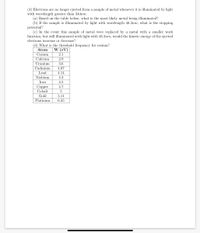Question

Transcribed Image Text:(4) Electrons are no longer ejected from a sample of metal whenever it is illuminated by light
with wavelength greater than 344nm.
(a) Based on the table below, what is the most likely metal being illuminated?
(b) If the sample is illuminated by light with wavelength 48.3nm, what is the stopping
potential?
(c) In the event this sample of metal were replaced by a metal with a smaller work
function, but still illuminated with light with 48.3nm, would the kinetic energy of the ejected
electrons increase or decrease?
(d) What is the threshold frequency for cesium?
W (eV)
Atom
Cesium
2.1
Calcium
2.9
Uranium
3.6
Cadmium
4.07
Lead
4.14
Niobium
4.3
Iron
4.5
Соpper
Cobalt
4.7
Gold
5.11
Platinum
6.35
Expert Solution
This question has been solved!
Explore an expertly crafted, step-by-step solution for a thorough understanding of key concepts.
Step by stepSolved in 6 steps

Knowledge Booster
Similar questions
- A light wave of a particular frequency hits a metal. The light wave is made of discrete photons, each with energy hf = hc/λ. An electron will either completely absorb a photon, or not at all. An electron in a metal needs an energy to leave the metal -- the work function (W). For the W given, calculate the maximum light wavelength (in nm) that will eject an electron. I will use electron-volts (eV) for energy, because the computer gives me trouble with very low numbers. hc = 1240 eV nm W = 3.9 eVarrow_forwardIn designing an experiment, you want a beam of photons and a beam of electrons with thesame wavelength of 0.281 nm, equal to the separation of the Na and Cl ions in a crystal ofNaCl. Find the energy of the photons and the kinetic energy of the electrons in electrovolts(eV).arrow_forwardIn an x-ray tube, the maximum photon energy is given by hf = qV. Would it be technically more correct to say hf = qV + BE, where BE is the binding energy of electrons in the target anode? Why isn’t the energy stated the latter way?arrow_forward
- Molybdenum has a work function of 4.20 eV. What is the stopping potential if the incident light has a wavelength of 180 nm?arrow_forwardIn a photoelectric effect experiment using UV light of wavelength 100 nm, a stopping voltage of V = 7.68 V is found. (a) Find the work function of the metal used. Using an appropriate table of work functions (in your text, for example), identify the metal. (b) Will there be a photoelectric effect using light of wavelength 200 nm? If so, find the stopping voltage. (c) Will there be a photoelectric effect using light of wavelength 400 nm? If so, find the stopping voltage.arrow_forwardFor x rays with wavelength 0.0300 nm, the m = 1 inten- sity maximum for a crystal occurs when the angle u in Fig. is 35.8°. At what angle u does the m = 1 maximum occur when a beam of 4.50 keV electrons is used instead? Assume that the electrons also scat- ter from the atoms in the surface plane of this same crystal.arrow_forward
arrow_back_ios
arrow_forward_ios